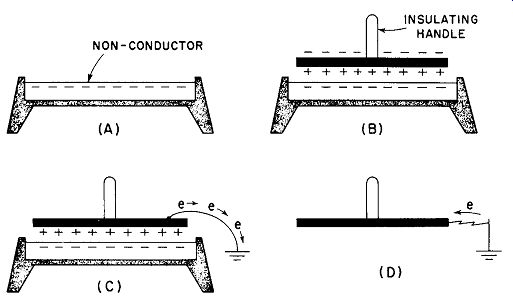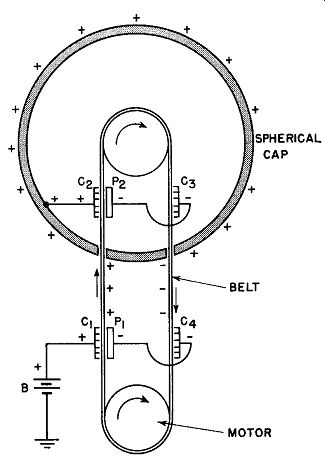AMAZON multi-meters discounts AMAZON oscilloscope discounts
33. The Electrophorus
The electrophorus, devised by Alexander Volta, gave one of the earliest demonstrations of the magnitude of charge that can be built by electrostatic induction ( Section 1). It consists of a disk of paraffin, hard rubber, or some similar insulating material and a metal disk movable by means of an insulated handle. (See Fig. 27.) There are four steps in its operation: First, the non-conducting material electrified negatively by friction, usually by rubbing it with cat's fur or flannel (A). The metal disk is now placed on top of the insulating base (B). Since the insulating material is far from perfectly smooth, the metal disk is actually spaced from it in most places, and contact between them is established only at a few points. A charge therefore appears on the metal plate by electrostatic induction, with the bottom of the disk positive and the top negative. A finger is then touched to the top of the disk (C), effectively grounding it. The ex cess negative charges are repelled to ground by the negative charge on the non-conductor, leaving the metal disk with a net positive charge. The finger is first removed, then the disk is lifted from the plate (D). When the disk is far enough away from the field of the plate, the charges upon it are free and a spark may be made to leap from the plate to a finger or through a glow-tube (neon, argon, etc.) to produce a sharp, bright glow. The process may now be repeated indefinitely without any loss to the initial frictional charge. At first glance, this seems to be a violation of the Law of Conservation of Energy, since energy is repeatedly obtained in the form of a spark or glow-tube flash without renewing the charge on the non-conducting plate. In this case, the energy comes from the mechanical work done in separating the disk against the attracting electric forces.
34. The Van de Graaff Generator

Fig. 27. Steps in the generation of charge with an electrophorus.
The principle of the electrophorus is applied in the operation of various types of static machines. The most spectacular and useful of these is the Van de Graaff generator diagrammed in Fig. 28. This generator can supply upwards of two million volts and is extensively used in atomic research.
A large spherical, highly-polished metal cap is supported on an insulating column (not shown) high above the ground. A motor drives a paper or plastic belt in the direction shown at high speed (50 to 60 miles per hour). The charging process is initiated by a source of high potential B, which sprays a positive charge onto the belt via a metal comb C1, which terminates in sharp points (Section 19). The positive charges are carried upward into the body of the sphere where they are picked off by comb C2 and led to the metal cap. Here they distribute themselves on the outside surface. At the same time, electrode P2 is charged negatively by induction from the ribbon, causing comb C3 to acquire the same charge. Thus, a negative charge is sprayed on the downward moving ribbon at this point.
These charges are then carried out of the cap to the region of comb C4. The negative charges are taken off by C4 and transferred to electrode P1, which again induces a positive charge in the ribbon.
At this time, the initiating source of potential may be removed, if desired, since the process is self-sustaining.

Fig. 28. Cross section of a Van de Graaff generator.
The field strength at the surface of the spherical cap is made as great as possible without a discharge taking place. The potential to which the sphere may be raised is proportional to the radius of curvature of its surface. For multimillion-volt machines ( since corona discharge starts at fields of a few megavolts per meter), it is essential that the cap have a large diameter. The Van de Graaff generator at the Carnegie Institute in Washington is 19 feet in diameter and 55 feet high; in the case of the Massachusetts Institute of Technology, the diameter is 15 feet.
As in the case of the electrophorus, the energy developed in the spherical cap is the outcome of the work done in moving charges against repelling and attracting electrostatic forces. As the left side of the belt moves toward the sphere, work must be done to overcome the repulsion of like charges; similarly, energy is expended in moving negative charges away from the sphere as the right side of the belt descends.
The intense electric field which surrounds the cap can change either positive or negative ions into high-speed, high-energy nuclear bullets for atomic research. Although other particle accelerators such as the cyclotron, the synchrocyclotron, the synchrotron, the beta-tron, and the beva-tron have gained in popularity in recent years, the Van de Graaff generator is still a useful tool and is not yet obsolete.
35. The Earth's Electric Field -- a Geophysical Problem
Although radar waves have reached far into space to reflect from the moon and return, and earthquake waves penetrate deep into the core of the earth to tell us something of its nature and structure, most of what we know of the earth is still gleaned from the thin blanket of tenuous gas which surrounds it. With such meager tools, it is no wonder that the problem of the origin and maintenance of the earth's electric field has never been solved completely. The information we possess is at best tentative, but as theoretical progress is made so will our ability to understand and manipulate the strings that control the earth's behavior improve. The research associated with the International Geophysical Year (particularly the satellite programs) has provided much new data.
The sea is an equipotential surface because it is an electrical conductor. As we move away from the surface of the earth, the electric potential rises to an average of about 100 volts per meter. This potential varies from place to place, from season to season, and to a great extent depends upon the topographical features of the terrain.
The potential gradient is severely affected by rain and clouds and in times of thunderstorms may rise to over 10,000 volts per meter. With the realization that the picture is a statistical one, we may conceive of the earth as a huge conducting sphere carrying a negative charge of about half a million coulombs of electricity, which is so distributed over its surface as to yield a potential gradient of approximately 100 volts per meter.
Within the first 6 miles of ascent, the field strength of the earth's electric field falls to about 5% of its value near the surface. This can be accounted for only by considering that the conductivity of the atmosphere increases with increasing altitude. In an idealized picture of the upper reaches of the earth's atmosphere, at altitudes of not much more than 60 miles, the atmosphere is considered as a perfect conductor. The resistance of the entire blanket of air boxed in between the surface of the earth and the upper conducting sphere has been measured as approximately 200 ohms. The half-million "average" coulombs of the earth's charge would leak off in four or five minutes in the form of atmospheric currents if some replacement mechanism were not in constant action.

Fig. 29. Charge distribution of the earth and a cloud during a thunderstorm.
The energy content of the thunderstorms that are always in progress somewhere on the surface of the earth is more than enough to account for the half-million coulomb charge of the earth. On a statistical basis again, best estimates give roughly 16 million thunder storms per year and perhaps 100 flashes of lightning per second! Although a flash may have a life of but a fraction of a second, with a million volts or more and a hundred thousand amperes involved in a single stroke, it is easy to explain the existence of a year-round average charge.
The typical thunderhead cloud has a charge distribution like that shown in Fig. 29. As its bottom surface comes closer to the surface of the earth, an opposite charge is induced along the ground.
When the difference of potential becomes great enough, a lightning discharge ensues.
Lightning is not made up of a single stroke. When a cloud-to earth discharge is about to begin, a comparatively thin leader stroke starts from the cloud and reaches the earth in a succession of short jumps. After contact between the leader stroke and the ground, a return stroke begins, following the path previously formed by the leader. It is this stroke that carries the enormous currents characteristic of lightning; its velocity often approaches one-half the velocity of light. A single lightning flash may comprise several of these pairs of leader and return strokes.
The separation of electric charges in thunderclouds is attributed to the disruption of water droplets by violently ascending air currents. Laboratory experiments show that a drop of water meeting a vertically rising column of air takes on a positive charge, while the air carries the negative charges upward. Rain from the lower part of a thunderhead is therefore generally negatively charged, while that from the upper portions bears a positive charge. Another phenomenon that may also explain the polarities exhibited by the earth is that condensation of moisture in the atmosphere takes place more easily around negative nuclei or electrons than it does around positive nuclei, and the fall of such drops to the earth will give it a negative charge. In fair weather, as mentioned before, the earth is negatively charged; sometimes during violent thunderstorms, there is a reversal of the gradient in localized regions.
36. QUIZ
1. Explain why it is possible to remove charge after charge from an electrophorus without recharging it.
2. Using the ratio of sphere diameters, how does the maximum voltage to which the Van de Graaff generator at the Carnegie Institute can be charged compare with that of the machine at the Massachusetts Institute of Technology?
4. With the help of a rough sketch, explain how a charge is built up on the sphere of a Van de Graaff generator.
5. What is the range of variation Qf the potential gradient of the earth from normal conditions to conditions of severe electrical disturbances?
6. What causes variations in the earth's potential gradient?
7. If the earth's charge were not being continuously maintained, how long would it take for complete discharge to occur? What do we believe is the charge-maintaining mechanism?
8. What is the normal polarity of the earth's charge?
9. Describe the method by which we believe electric-charge separation occurs in thunderclouds.
10. What is the sequence of events involved in the production of a lightning stroke?